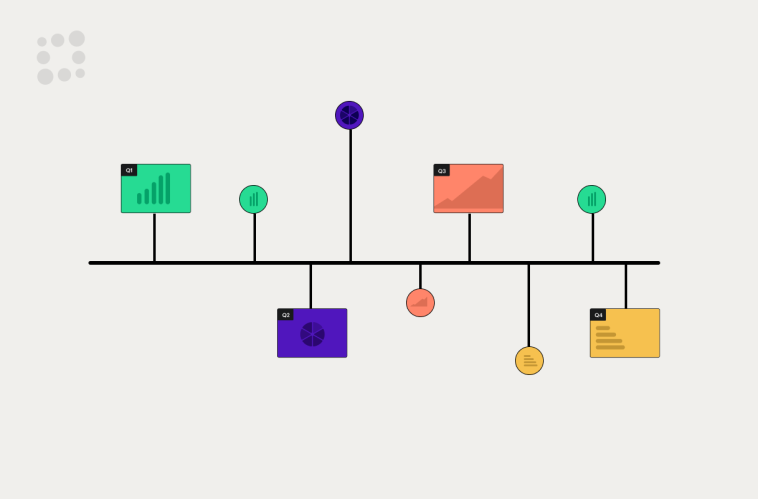- Like
- SHARE
- Digg
- Del
- Tumblr
- VKontakte
- Flattr
- Buffer
- Love This
- Save
- Odnoklassniki
- Meneame
- Blogger
- Amazon
- Yahoo Mail
- Gmail
- AOL
- Newsvine
- HackerNews
- Evernote
- MySpace
- Mail.ru
- Viadeo
- Line
- Comments
- Yummly
- SMS
- Viber
- Telegram
- JOIN
- Skype
- Facebook Messenger
- Kakao
- LiveJournal
- Yammer
- Edgar
- Fintel
- Mix
- Instapaper
- Copy Link
Why Your QBR SaaS Model Needs an AI Makeover
Quarterly business reviews (QBRs)[LINK] have become a standard practice for software providers, but today’s QBR SaaS model is rapidly transforming. The traditional fixed quarterly review is being replaced by real-time performance monitoring and artificial intelligence data analysis, enabling you to stay engaged with clients between scheduled reviews.
Here we’ll show you how to update your SaaS QBR strategy to keep up with the latest technology and best practices. First, we’ll examine what a SaaS QBR is and why they’ve become so important. Then we’ll look at how digital technology has made the traditional QBR outdated and how AI is helping software providers increase the efficiency of SaaS QBRs. Finally, we’ll offer some tips on updating your QBR SaaS strategy to leverage the latest technology and best practices.
What Is a QBR in SaaS?
A Quarterly Business Review (QBR) in SaaS is a periodic meeting scheduled with a client every three months to assess performance and plan strategic adjustments. This helps to ensure that your product delivers the value your client expects while underscoring the value your client is receiving, laying the groundwork for subscription renewal by satisfied customers.
SaaS QBR meeting agendas[LINK] typically cover:
- A review of progress toward goals established during previous quarterly business reviews
- An analysis of factors contributing to performance, particularly any causing gaps between goals and performance
- Updating goals, strategies, and KPIs to pursue future objectives
QBRs in SaaS usually involve business clients, particularly clients with larger accounts, requiring more attention. B2B clients tend to measure performance in terms of key performance indicators, so SaaS QBR discussions often focus on KPIs. Success managers and clients may use previously established KPIs to evaluate current performance and discuss which KPIs and target numbers would be appropriate in the future. Multiple decision-makers at client companies may have input at reviews, including the client’s regular contact personnel and procurement managers, CEOs, or other stakeholders interested in evaluating SaaS services’ performance.
Why Are SaaS QBRs Important?
QBR SaaS performance reviews serve several valuable functions for both software providers and their clients. In general, QBR meetings help ensure that SaaS clients receive the value they’re paying for from their software provider, promoting higher subscription renewal, upsell, and referral rates. This breaks down into several specific benefits:
- Quarterly business reviews give SaaS success managers opportunities to meet with decision-makers at client companies regularly, building long-term relationships
- QBRs provide a more precise understanding of client’s needs, motivations, and goals
- QBR sessions allow you to collaborate with clients on developing strategies to meet their objectives
- Quarterly reviews let you and your client agree on which key performance indicators will be used to evaluate progress toward client goals
- By focusing on KPIs, QBRs provide transparency in communications with clients
- QBRs provide a way to showcase the value you deliver to clients using measurable, objective criteria
- A QBR session allows you and clients to make adjustments to ensure that they’re receiving an acceptable level of value
- By helping you deliver value clients want, QBRs increase customer satisfaction, promoting higher renewal rates, upsells, and referrals, along with lower churn
- The better understanding of client needs that QBRs provide you preemptively reduce support issues, freeing up your staff to support more clients
Overall, the benefits of SaaS QBRs boil down to higher subscription renewal rates and more revenue from upsells and referrals. QBR meetings can be particularly profitable for SaaS brands that serve high-volume B2B clients who prioritize measurable value when making purchasing decisions.
Is the Traditional SaaS QBR Model Still Working?
While the benefits of conducting QBR SaaS meetings can be significant, the traditional SaaS QBR model has some inherent drawbacks that require an upgraded approach. As the name implies, the traditional quarterly business review is conducted once every three months. This means that you and your client may be discussing data that is as much as 90 days old, which can put you at a disadvantage in several ways:
- If a problem emerged shortly after your last quarterly business meeting, three months when you could have taken steps to correct it have gone by, and an issue that could have been fixed may have gotten worse
- If a problem has developed more recently concerning your upcoming QBR meeting, this may diminish the value your client is receiving, catching you off-guard and undercutting the effectiveness of your meeting
- On the other hand, if your product has been over-performing for your client, you won’t know this going into your QBR meeting
- If you and your client only review data between QBR meetings, neither of you are enjoying access to real-time data
- Lack of access to real-time data prevents you from leveraging artificial intelligence to deploy real-time business insights into all the data from your client’s digital channels
- If your competitors or your client’s competitors are using AI, this puts you at a competitive disadvantage in serving your client
These disadvantages mean that a traditional QBR model is no longer optimal for SaaS providers. In addition to relying on outdated data, the traditional QBR model fails to take advantage of the latest tools for agile innovation in digital technology, AI, and big data analytics. Today’s competitive SaaS company needs a digital, data-driven, AI-powered approach to QBRs for SaaS.
Reimagining the SaaS QBR
To reconceive the SaaS QBR for optimized use today, a starting point is rethinking the “Q” for “quarterly.” With digital technology, you’re not limited to reviewing data with clients only once a quarter and running the risk of letting preventable issues get out of control. You and your client can monitor real-time data to allow you to pivot quickly when your goals get off track. Real-time data enables your client to make informed decisions based on current market conditions rather than based on old data aggregated over the course of a quarter. While you and your client may still choose to hold quarterly reviews as a routine procedure, you can establish additional procedures to fill the gap between QBRs at strategic points in your client’s customer journey.
For example, you and your client can use your initial meeting to set performance goals and parameters that represent deviations from those goals warranting a review. To illustrate, let’s say your SaaS product is designed to deliver clients a specific conversion rate on their website opt-in forms. You and your client might assign a certain margin of deviation from this conversion rate as a situation that calls for investigation and review.
Reviews don’t need to be limited to adverse situations, either. You might set in-house criteria for exceptional performance, which alert your sales team that a client might be open to an upsell. Similarly, you might use satisfaction criteria such as Net Promoter Score to indicate that a customer might be a good brand advocate. You and your team don’t necessarily have to wait until your next scheduled QBR to put this type of information into action.
In this context, you can approach QBRs as real-time anytime customer business reviews rather than merely formal quarterly events. Your reviews can be forward-thinking and geared toward identifying any engagement opportunities which would help you keep the value your client is receiving from your product aligned with their business goals.
This approach gives your customer success team maximum advantage over your QBR strategy. You can build your QBRs into a comprehensive customer journey management plan for engaging your customers in real-time throughout their life cycle with your product to ensure that they receive maximum value from your brand.
Planning Your New SaaS QBR Strategy
To implement an up-to-date QBR SaaS strategy that makes full use of today’s technology, here are some action steps you can take:
- Lay a foundation for success by adopting a customer success platform that lets you build QBRs into your customer journey map by monitoring customer data in real-time. Totango’s platform has out-of-the-box modules with built-in KPIs and automatically triggered workflows to optimize each stage of your customer’s journey.
- Review your customer journey map and identify where QBRs would best fit in your customer life cycle and what strategic events might trigger occasions for unscheduled customer reviews.
- Create a SaaS QBR template to help you plan your standard procedures for what to cover in QBR meetings
- Include a list of discovery questions as well as KPIs to discuss with your customers as possible SMART performance metrics
- Establish post-QBR standard operating procedures defining when to contact customers between scheduled QBR sessions
If you’re already doing traditional quarterly business reviews, you’ll need to consider integrating your existing practice into your new, flexible review strategy. An excellent way to do this is to review your current QBR format in light of your customer journey map and use it as a basis for making adjustments and adding any relevant KPIs. Depending on what type of KPI monitoring you’re already doing, you may need to set up additional monitoring mechanisms.
Update Your SaaS QBR Strategy to Deliver Better Results to Your Customers
For SaaS companies, digital technology revolutionizes the traditional fixed-schedule QBR, which lets companies stay engaged with customers in real-time between scheduled reviews. This enables you to keep customers informed on up-to-the-minute intelligence, helping you make adjustments that will allow you to meet goals set during quarterly reviews and even update goals when needed. This yields better results and higher customer satisfaction, translating into higher retention, lower churn, and higher revenue.
Totango’s customer success platform provides out-of-the-box KPIs and dashboard monitoring tools you can use to provide your team and your customers with real-time updates at any time, not just once a quarter. With the Totango Reports Factory, you can automate your QBRs by exporting customer data straight into your slide decks. Start for free today to transform your QBR strategy into dynamic real-time results for your customers.





